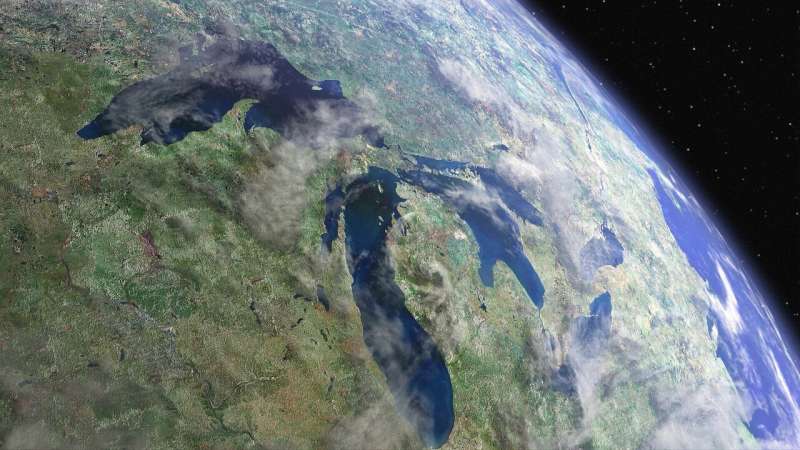This article has been reviewed according to Science X's editorial process and policies. Editors have highlighted the following attributes while ensuring the content's credibility:
fact-checked
trusted source
proofread
New guiding principles urgently needed for Great Lakes stewardship, researchers say

The tools and policies that have worked to significantly reduce threats to the Great Lakes over the past century are ill-equipped to handle today's complex and interrelated challenges.
A new set of stewardship principles is needed to work holistically and systematically on long-term social, economic, environmental, and racial-equity and resiliency concerns that have too often been sidelined in a rush for immediate results.
That's the main message of a recently published commentary by 12 University of Michigan researchers who say Great Lakes management is at a crossroads and that now is the time to implement true 21st-century stewardship. The paper is published in the Journal of Great Lakes Research.
What's needed is a set of guiding principles focused on managing the Great Lakes at the ecosystem scale, centering justice, embracing the blue economy and the energy transformation, and prioritizing community partnerships, according to the commentary authors.
"We're essentially proposing a new way to approach Great Lakes management and governance and believe that now is the time to make these substantial changes because of the major issues facing the Great Lakes and the region," said Mike Shriberg, lead author of the work.
Shriberg is a professor of practice and engagement at U-M's School for Environment and Sustainability and director of engagement for the Cooperative Institute for Great Lakes Research and Michigan Sea Grant. He will summarize the commentary Aug. 15 in Detroit at a public engagement session sponsored by the U.S. Environmental Protection Agency.
The EPA is gathering input as it prepares to update the action plan for the Great Lakes Restoration Initiative, which has allocated some $3.8 billion to more than 4,000 restoration projects since its inception in 2010. With an infusion of an additional $1 billion into the GLRI from the American Recovery & Reinvestment Act, the Great Lakes initiative is "nearing the end of a key phase of remediating past harms and can now focus more effort and attention toward envisioning and funding the future," according to the U-M commentary.
At the same time, the federal government plans to update the Great Lakes Regional Collaboration Strategy, which was drafted more than 20 years ago and does not reference some key present-day challenges to the Great Lakes.
"The foundations of our Great Lakes policies and institutions are typically well-intentioned and sometimes well-functioning, but they date from a bygone era and are often no longer applicable to 21st-century challenges," Shriberg said.
Those challenges include:
- Climate variability and change. Great Lakes water levels are rising and falling rapidly and unpredictably, increasing erosion and threatening wildlife habitats and communities. In addition, heavier storms challenge aging infrastructure.
- Water scarcity and diversions. As water scarcity accelerates in the Great Plains and the American Southwest, pressure to divert Great Lakes water via pipelines, canals and ships will continue to grow. Current safeguards against diversions may not be enough, particularly given the greater political clout of other parts of the country.
- Water inaccessibility and unaffordability. As water prices rise and infrastructure challenges multiply, the most vulnerable people in the region continue to lack access to safe, affordable water.
- Environmental injustice. The environmental and health impacts of damaging practices are unequally distributed, with less well-resourced communities shouldering a disproportionate burden: "Whether through unsafe labor conditions, denial of treaty rights or disproportionately high burdens of pollution, Black, Brown and Indigenous peoples have endured generations of harm, violence, pollution and lack of access to outdoor spaces."
- Emerging contaminants. Current Great Lakes environmental policies were designed mainly to address concentrated "point sources" of pollution, such as factories. Today, we are learning more about the severe consequences of even low levels of Persistent Bioaccumulative Toxins and other powerful and dispersed contaminants. Traditional approaches that rely on treatment and discharge regulation are inadequate.
- Invasive species. Invasive species continue to alter and decimate Great Lakes food webs, threatening the prospects for restoration and causing increasingly chaotic consequences for native species.
- Harmful algal blooms. More intensive agriculture is combining with increasing frequency of extreme precipitation and higher water temperatures to increase the number, intensity and nature of harmful algal blooms across the region.
"A longer list is possible, but the point is this: These complex, interrelated, generational problems require innovative policy and funding solutions, and in turn, demand coordinated multiparty and multijurisdictional (including binational) action," according to the commentary authors.
"The emerging effort to collectively restructure the federal plan for the Great Lakes management and the current openness to new approaches represents a potential turning point, a critical opportunity to build off of past restoration successes and set our region on a pathway for a resilient, thriving Great Lakes future," they wrote.
More information: Mike Shriberg et al, Leadership for the next generation of Great Lakes stewardship, Journal of Great Lakes Research (2023). DOI: 10.1016/j.jglr.2023.06.011
Provided by University of Michigan


















